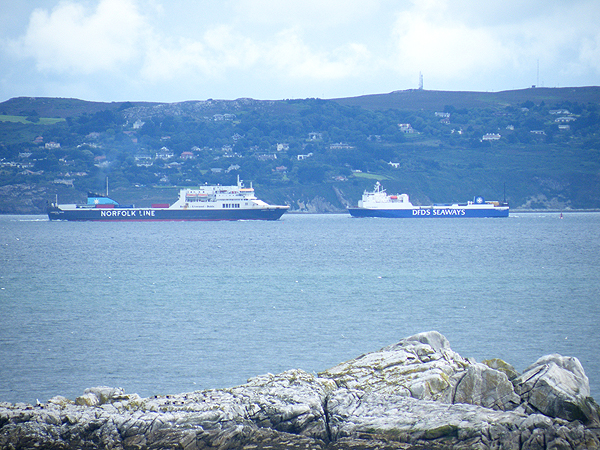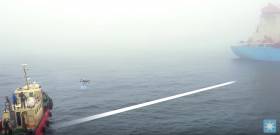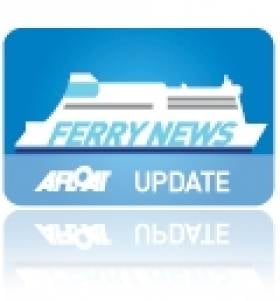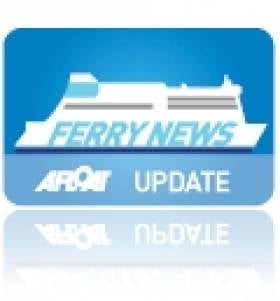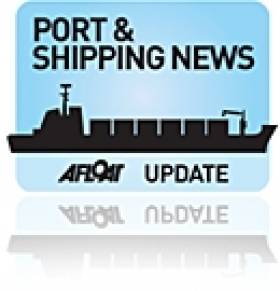Displaying items by tag: maersk
Maersk And MSC Expand Transatlantic Route Out of Liverpool Following Disruption At Felixstowe
#shipping - The collaboration between Maersk and MSC of the 2M shipping alliance, formed from the two biggest container lines in the world by market share, has committed to a permanent transatlantic shipping route connecting Liverpool, UK, with several US ports, according to a statement from Peel Ports.
The announcement reports Port Technology, follows the introduction of a temporary call in July 2018 by 2M after severe disruption at the Port of Felixstowe.
At present, the service is currently being used to export UK cargo, such as food produce and retail, but, according to Peel Ports, is attracting interest for trade in manufacturing and industrial goods.
The service will use a port rotation that takes in Antwerp, Rotterdam, Bremerhaven, Liverpool, Newark, Savannah, Port Everglades and North Charleston.
The commitment from 2M is the latest in a series of logistical and shipping milestones for the Port of Liverpool.
For further details of this new UK-USA lo-lo route service, click here.
Drone Technology to Cut Delivery Costs to Ships
In the shipping and tanker business, it can be hard to predict far in advance which port will be called to next and even when in port, it can be complicated and expensive to deliver items to vessels as they are not alongside the quay. Drone technology offers a solution to this and Maersk Group have been trialling it at sea.
Drones could cut time and costs for deliveries and inspections – but shipping lines say they must be reliable and absolutely safe. Maersk Tankers is testing delivery to vessels on drones that have been certified for explosive environments.
Costs for a barge are on average USD 1,000 and can be higher. That means, drone use could with the current payload bring potential savings of USD 3,000-9,000 per vessel per year, Maersk Tankers estimates.
Seatruck Sailings Start on Dublin-Heysham Route
The vessel has accommodation for 12 drivers. Most of the daily sailings depart Dublin at 15:15hrs and return from the Lancashire port at 02:15hrs. On certain days the schedules vary, to view the timetable click here.
In addition to the new route for Seatruck Ferries, the freight-only operator has a fleet of 8 vessels on routes between Dublin-Liverpool, Warrenpoint-Heysham and Larne-Heysham.
Anglia Seaways arrived into Dublin yesterday morning from Avonmouth Docks, where the 120 unit capacity vessel went into temporary lay-up period, since departing the Irish capital on 31 January (see related posting and photo).
The 13,073grt vessel revived the 8-hour route yesterday with an afternoon sailing bound for Heysham. The vessel was originally reported to be relocated to Baltic Sea operations, but with its charter to Seatruck, the DFDS Seaways funnel symbol of the Maltese cross was painted out.
Though, the Maltese cross can still be seen in Irish ports with calls made by sisterships, Dana Gothia (ex. Maersk Westland) and Dana Hollandia (formerly Maersk Waterford) which are part of the DFDS Group container subsidiary DFDS Logistics.
In total the Lo-Lo shipping division operates four vessels on several routing options with weekly calls to Belfast, Dublin, Cork and Waterford to Rotterdam and Zeebrugge.
The German built sisters originally operated Dublin-Rotterdam and Waterford-Rotterdam routes for Norfolk Line (a subsidiary of Maersk / A.P. Moller Group).Incidentally Maersk /Norfolkline also owned the Anglia Seaways until DFDS Seaways purchased the vessel last year.
DFDS Seaways Makes Final Irish Sea Departure
The ro-pax Dublin Seaways made a last crossing with a Saturday morning arrival at Birkenhead. After disembarking passengers, vehicles and freight traffic, the 21,856grt vessel immediately departed the Mersey for a short-term deployment on the company's North Sea Rosyth-Zeebrugge service.
Sistership, Liverpool Seaways also completed her last crossing to Birkenhead with an overnight Saturday sailing. This was the final scheduled sailing under DFDS Seaways ownership and marked the last foot-passenger crossing on the Liverpool route as rival operators P&O (Irish Sea) and Seatruck Ferries do not cater for this market.
The vessel returned to Dublin yesterday from Birkenhead; this was to facilitate the loading of drop-trailers and terminal based tugmasters (engine-driven truck/cabs) that tow unaccompanied trailers on the roll-on roll-off vessels. After a short turn around at the terminal, Liverpool Seaways departed Dublin, bound for Immingham. The UK east coast port is where DFDS operate an extensive freight route network across the North Sea.
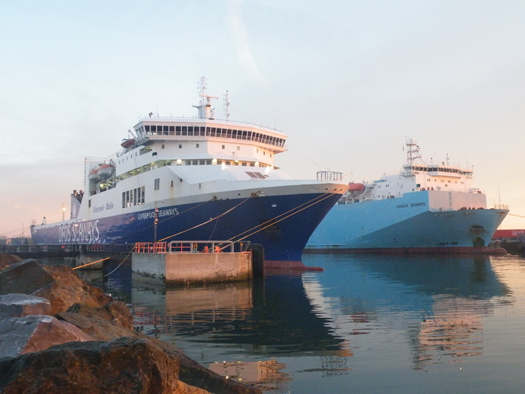
The ro-pax Liverpool Seaways and freight-ferry Anglia Seaways berthed in Dublin Port yesterday prior to sailing away from the Irish Sea. Photo Jehan Ashmore / ShipSNAPS
In addition the 13,704grt Anglia Seaways also docked in Dublin yesterday from Heysham to perform similar duties like the Liverpool Seaways. Several hours later, the 114-trailer capacity vessel set a southbound course past The Muglins, bound for Avonmouth.
DFDS cited its decision to exit entirely from Irish Sea sector due to the sharp decline in the Irish and UK economies in 2008 and 2009. The company suffered continuous losses on its remaining routes and the issue of over-capacity, particularly on the north Irish Sea.
Only last December, the Danish owned shipping operator sold its other two Irish Sea routes to Stena Line in a £40m acquisition deal. This is all the more remarkable considering DFDS Seaways purchased the previous route operator, Norfolkline's Irish Sea division of their four routes and seven vessels, in July 2010.
The sale to Stena covered the three terminals used on the Belfast routes to Birkenhead and Heysham, which is another freight-only service. In addition the acquisition involved the sale of the South Korean built freight-ferries Hibernia Seaways and Scotia Seaways; like the Anglia Seaways they were all former Norfolkline / Maersk Line vessels.
Interestingly the acquisition is to include the purchase of the chartered 27,510grt ro-pax sisters Lagan Seaways and Mersey Seaways. When the Visentini built sisters were completed at the Italian shipyard, they were placed on the Belfast-Birkenhead route in 2005.
On 1 December Stena Line UK Ltd acquired DFDS Seaways Irish Sea Ferries Ltd (since renamed Stena Line Irish Ferries Ltd). Although the acquisition of SL ISF by Stena Line has been completed and DFDS no longer owns SL ISF, Stena Line await formal approval from the Irish competition authority and the UK's Office of Fair Trading (OFT) to integrate SL ISF into the wider Stena Line business.
In the meantime during this transitional period, it is business as usual for customers using the Belfast-Birkenhead and Belfast-Heysham routes. Online bookings continue to be accepted on www.dfdsseaways.com or tel: (01) 819 2999 and in the UK tel: 0871 230 033
DFDS Seaways Show True Colours on Irish Sea
The acquisition of Norfolk Line (a subsidairy of Danish shipping giant, Maersk) by DFDS Seaways was finally completed in July writes Jehan Ashmore. Though it is only now that the visual signs of this takeover are becoming increasingly apparent on the Irish Sea.
The Maersk Exporter, was the first of the former Norfolk Line fleet to undergo changes with a new corporate livery scheme. This saw the pale 'Maersk' blue hull colours replaced with a darker shade of blue representing DFDS Seaways. The Chinese built 114-truck trailer freight-ferry was dry-docked at Cammell Laird shipyard, Birkenhead to emerge on the Mersey also sporting a new name, Scotia Seaways. Sisterships, Maersk Importer has been re-named Hibernia Seaways leaving the third in the trio of 13,000 gross tonnes freighters, Maersk Anglia to receive re-branding.
DFDS Seaways not only operate these vessels but also a pair of freight-ferries on routes from Heysham to Belfast, Dublin and Larne, the later route was only launched in May. In addition DFDS inherit four ro-pax passenger ferries, built at the Italian Visentini shipyard, that Norfolkline operated from Twelve Quays Ferry Terminal, Birkenhead on routes to Belfast and Dublin.
The acquisition will see DFDS Seaways continue to operate these vessels and routes. This has also led to a phased rebranding of the ferry fleet. On the Birkenhead-Belfast route, the newly renamed Mersey Seaways (ex. Mersey Viking) is also joined by Dublin Seaways (ex. Dublin Viking) which is away from the Dublin route to deputise while
the Lagan Seaways (ex. Liverpool Viking) currently undergoes a similar re-branding exercise at Cammel Laird. Birkenhead-Dublin sailings are covered by Liverpool Seaways (ex. Liverpool Viking) which made an inaugural call to Dublin on 18 August, under the new name, albeit retaining most of the predecessors livery. With Dublin Seaways serving Belfast sailings, DFDS Seaways chartered P&O Ferries, Dover-based ro-pax European Endeavour, allowing Lagan Seaways to be dry-docked.
DFDS Seaways entry onto the Irish Sea scene is set amidst challenging market conditions as the ferry industry faces issues of over-capacity and reduced trade from the heady boom years. The most intense competition is on the central corridor routes, particularly Dublin to Merseyside (Birkenhead/Liverpool) and the shorter-sea route to Holyhead.
Outside the Irish Sea, DFDS Seaways, are a large transport and logistics operator with over 60 vessels operating an extensive route network stretching across western Europe, from the English Channel, the North Sea, Scandinavia and as far east to the Baltic Sea port of St. Peterburgh in the Russian Federation.
